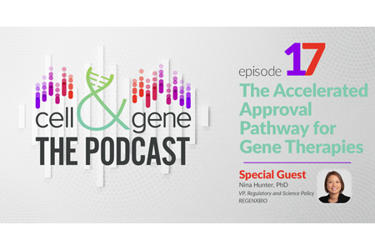Requirements Of The Accelerated Approval Pathway

By Erin Harris, Editor-In-Chief, Cell & Gene
Follow Me On Twitter @ErinHarris_1

About 80% of cell and gene therapies address high unmet medical needs, either rare diseases or cancer. The forecast is about 800,000 patients will be treated by approved cell and gene therapy drugs by 2030. This means that now is a boom time for CGT companies with the majority being in North America. The type of CGT products are completely novel or incremental improvements on existing products. While any drug development program can face regulatory hurdles, developing cellular and gene therapies often presents unique challenges.
The accelerated approval pathway has been highlighted for approvals decisions. As REGENXBIO’s Nina Hunter, Ph.D. states on Episode 17 of Cell & Gene: The Podcast, the term is a regulatory term, and it does not simply mean to move quickly. Rather, the accelerated approval pathway is a powerful tool, which has its own distinct set of criteria. The approval pathway was developed for a specific reason; it is not meant for any and every disease. When a drug has been granted approval, the drug is not to be considered of lesser value. Hunter explains why the accelerated approval pathway is pertinent for gene therapies, and why it was developed to be flexible.
Indeed, compared to traditional approval, the accelerated approval pathway has brought therapies to market several years sooner. According to Avalere, a 2011 study published in the Journal of the National Cancer Institute found that oncology products approved via the pathway were brought to market 4.7 years faster than traditionally approved oncology products, representing a significant decrease in the time to bring a drug to market. The accelerated approval pathway may become more relevant for pipeline therapies coming to market in the next decade, including many cell and gene therapies. Like products that have historically been approved through the accelerated approval pathway, many therapies in the pipeline are also products intended to treat rare diseases with unmet medical need. Specifically, Avalere examined about 200 unique products in the Phase I, II, and III pipeline, including therapies with special FDA designations (i.e., orphan drug designation, regenerative medicine advanced therapy (RMAT), breakthrough therapy, fast track, and priority review) and therapies determined to be administered in one or a few administrations (Figure 3).1 Many of these therapies are being developed to treat rare and serious conditions such as rare cancers, muscular dystrophy, hemophilia, and sickle cell anemia. In fact, about 80% of all pipeline therapies analyzed have orphan drug designation from the FDA.
For more on the accelerated approval pathway for gene therapies as well as the current potential regulatory roadblocks for gene therapies, how identifying biomarkers and surrogate endpoints helps address regulatory roadblocks, and how public/private collaborations help usher in the next wave of gene therapies, check out Cell & Gene: The Podcast.
